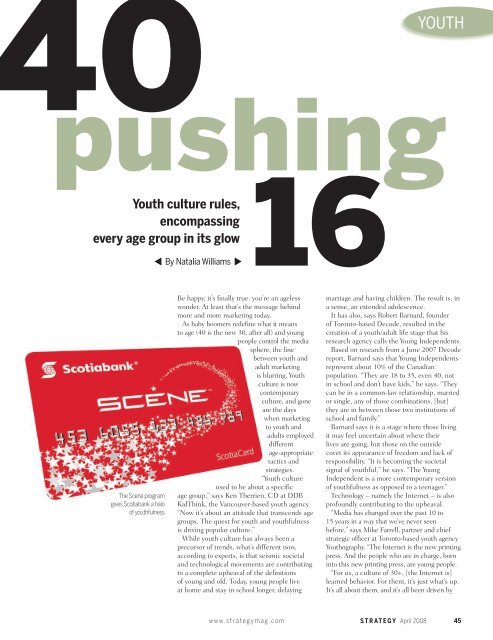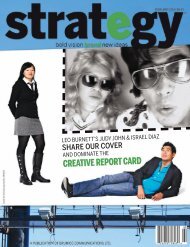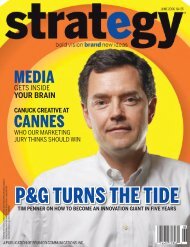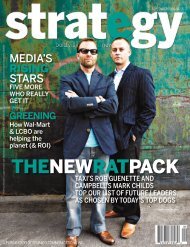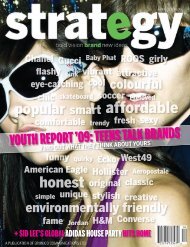Download PDF - Strategy
Download PDF - Strategy
Download PDF - Strategy
You also want an ePaper? Increase the reach of your titles
YUMPU automatically turns print PDFs into web optimized ePapers that Google loves.
0<br />
By Natalia Williams<br />
Be happy, it’s fi nally true: you’re an ageless<br />
wonder. At least that’s the message behind<br />
more and more marketing today.<br />
As baby boomers redefi ne what it means<br />
to age (40 is the new 30, after all) and young<br />
people control the media<br />
sphere, the line<br />
between youth and<br />
adult marketing<br />
is blurring. Youth<br />
culture is now<br />
contemporary<br />
culture, and gone<br />
are the days<br />
when marketing<br />
to youth and<br />
adults employed<br />
different<br />
age-appropriate<br />
tactics and<br />
strategies.<br />
“Youth culture<br />
used to be about a specifi c<br />
age group,” says Ken Therrien, CD at DDB<br />
KidThink, the Vancouver-based youth agency.<br />
“Now it’s about an attitude that transcends age<br />
groups. The quest for youth and youthfulness<br />
is driving popular culture.”<br />
While youth culture has always been a<br />
precursor of trends, what’s different now,<br />
according to experts, is that seismic societal<br />
and technological movements are contributing<br />
to a complete upheaval of the defi nitions<br />
of young and old. Today, young people live<br />
at home and stay in school longer, delaying<br />
YOUTH<br />
pushing<br />
Youth culture rules,<br />
encompassing<br />
every age group in its glow<br />
The Scene program<br />
gives Scotiabank a halo<br />
of youthfulness<br />
16<br />
marriage and having children. The result is, in<br />
a sense, an extended adolescence.<br />
It has also, says Robert Barnard, founder<br />
of Toronto-based Decode, resulted in the<br />
creation of a youth/adult life stage that his<br />
research agency calls the Young Independents.<br />
Based on research from a June 2007 Decode<br />
report, Barnard says that Young Independents<br />
represent about 10% of the Canadian<br />
population. “They are 18 to 35, even 40, not<br />
in school and don’t have kids,” he says. “They<br />
can be in a common-law relationship, married<br />
or single, any of those combinations, [but]<br />
they are in between those two institutions of<br />
school and family.”<br />
Barnard says it is a stage where those living<br />
it may feel uncertain about where their<br />
lives are going, but those on the outside<br />
covet its appearance of freedom and lack of<br />
responsibility. “It is becoming the societal<br />
signal of youthful,” he says. “The Young<br />
Independent is a more contemporary version<br />
of youthfulness as opposed to a teenager.”<br />
Technology – namely the Internet – is also<br />
profoundly contributing to the upheaval.<br />
“Media has changed over the past 10 to<br />
15 years in a way that we’ve never seen<br />
before,” says Mike Farrell, partner and chief<br />
strategic offi cer at Toronto-based youth agency<br />
Youthography. “The Internet is the new printing<br />
press. And the people who are in charge, born<br />
into this new printing press, are young people.<br />
“For us, a culture of 30+, [the Internet is]<br />
learned behavior. For them, it’s just what’s up.<br />
It’s all about them, and it’s all been driven by<br />
www.strategymag.com STRATEGY April 2008 45


